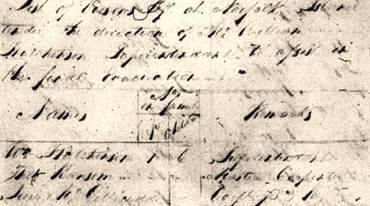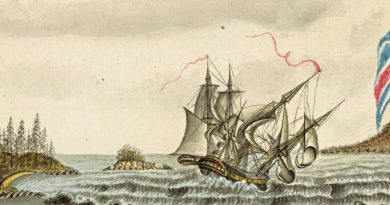Draught (Draft) plans of HMS Berwick – HMS Sirius
HMS Sirius was originally the merchant ship Berwick, which was refitted out as HMS Berwick in early 1782 by the Royal Navy. The ship was commissioned to escort the First Fleet and renamed HMS Sirius in October 1786. HMS Sirius was the flagship of the first fleet.
Fred Spring an ex Qantas draughtsman and specialist in British ships donated the original draught plans of HMS Sirius, with a scale of scale 1: 48 and 415 mm x 552 mm in size in 1961 to the National Maritime Museum, Greenwich London who considered Fred Spring a naval draughtsman expert.
 Another copy of the draught (sic) of HMS Berwick – HMS Sirius by Fred Spring was donated to the Sirius museum Norfolk Island by his good friend John Shortland of Sydney. Cathy Dunn from Australian History Research presented this with the 2016 Norfolk Island History Lovers tour to Janelle Blucher, KAVHA Heritage Management, Norfolk Island Museums in November 2016.
Another copy of the draught (sic) of HMS Berwick – HMS Sirius by Fred Spring was donated to the Sirius museum Norfolk Island by his good friend John Shortland of Sydney. Cathy Dunn from Australian History Research presented this with the 2016 Norfolk Island History Lovers tour to Janelle Blucher, KAVHA Heritage Management, Norfolk Island Museums in November 2016.
This draft plan which is labeled draught shows the running rigging of HMS Sirius (late HMS Berwick), the only other copy being 800mm x 1300mm in size, albeit quite large now has a new home at the Sirius Museum not far from the final watery resting place of HMS Sirius which was ship wrecked on Norfolk Island on 19 March 1790.
Australian History Research and Norfolk Island Museums thank John Shortland for the wonderful donation of the draught plans of HMS Sirius to Norfolk Island.
John Shortland of Sydney attended the Norfolk Island History Lovers Tour in 2014 and is descendant of the Shortland family of the First Fleet 1788, which includes John Shortland of HMS Sirius John Shortland, son of Royal Navy. Lt. John Shortland.
John Shortland was stranded on Norfolk Island in March 1790 after the shipwreck and from getting the provisions on shore after the wreck, his health was greatly injured. For several successive nights, he slept upon wet sales, which subjected him ever afterwards to the most excruciating and almost constant rheumatic pains. In February 1791, John returned to Sydney aboard HMAT Supply he then embarked on the Dutch vessel Waaksamheid for England as Master’s Mate. John was appointed 1st Lieutenant to HMS Reliance, and returned to NSW in 1795. Henry Waterhouse (ex HMS Sirius and now Second Captain HMS Reliance) along with John Shortland bought the first pure merino sheep to NSW from the Cape of Good Hope aboard HMS Reliance in 1796, selling some to John McArthur, founder of the Australian Wool Industry.
 In September 1797, while in pursuit of escaped convicts, Lieutenant John Shortland discovered the Hunter River. He explored and named the river, after his former Captain John Hunter of HMS Sirius and now the Governor of NSW. John also made the first chart of the Newcastle – Hunter River harbour and collected samples of coal.
In September 1797, while in pursuit of escaped convicts, Lieutenant John Shortland discovered the Hunter River. He explored and named the river, after his former Captain John Hunter of HMS Sirius and now the Governor of NSW. John also made the first chart of the Newcastle – Hunter River harbour and collected samples of coal.
Image: Captain John Shortland, 1769 -1810. It originally accompanied a memoir of Shortland published in the Naval Chronicle in July 1810. Royal Museum Greenwich England.
The suburb of Shortland in Newcastle is name after John Shortland along with Shortland Wetlands, Shortland Esplanade by the beach, Shortland Waters Golf Club, a historic fountain in Christie Park outside City Hall, the federal electorate of Shortland. John returned to England in 1800 and served with the navy aboard the Pandora, Dolphin, Trompeuse and Junon. John was mortally wounded received in an engagement with the French, he died 21 January 1810 and buried at Basseterre cemetery Guadaloupe receiving a parole a’honneur in which his body was interred with full Military Honours.


